Central Library Building
1926 – Bertram Grosvenor Goodhue with Carleton Monroe Winslow
630 West Fifth Street – map
Declared: 3/1/67
the old L.A. Public Library burned
down
that library downtown
and with it went
a large part of my
youth.
-- “the burning of the dream”, Charles Bukowski
So about 86% of the information in this post is taken from the official website of the Los Angeles Public Library, technically the Richard J. Riordan Central Library. (Since 2001, the library's been renamed after the city’s mayor of 1993 to 2001 - never mind it had been called the Von Kleinsmid Library for Rufus B. von Kleinsmid, USC president and library commissioner. Poor Rufus.)
The Mark Taper Auditorium
Los Angeles’s library was established in December of 1872 at Temple and Springs Streets. The state legislature passed an enabling act for a public library in the city in 1874, and the library was transferred to the care of the city in 1878. Harris Newmark, in his Sixty Years in Southern California 1853 - 1913, reports one of the first efforts to form a public library was made in 1859 with the undertaking not being all that well received.
The Literate Fence, grillwork by Ries Niemi, fronting Fifth Street.
As an architect, Bertram Goodhue had been famous for the state capitol building in Lincoln, Nebraska, and Manhattan’s Church of the Intercession where he's buried. A long-time partner of Goodhue’s, Carleton Winslow was responsible for a bunch of buildings throughout Southern California, including the First Baptist Church of Pasadena. The library was built over a good chunk of the early 1920s, being dedicated on July 15, 1926. Goodhue, however, died in 1924, never seeing the finished product.
Compare all this newer section to the left with the broad lawn in the picture below.
That's the California Club under construction in the background, right?
As early as the 1950s, the city began to consider that the Central Library Building had outstayed its welcome and should be removed. In the 1970s, it became more and more likely the library would be torn down. The battle to preserve the library was the impetus behind the 1978 formation of the Los Angeles Conservancy. In 1983, the city decided to save and restore the building.
The Grand Avenue side. This is the new section named after Tom Bradley.
The Hope Street entrance.
"Wisdom is the ripest fruit of much reflection", except with v's for u's.
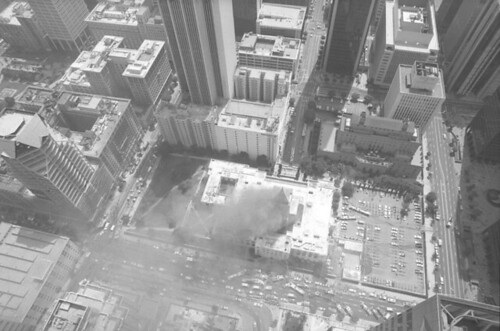
The April 29, 1986, fire.
Before the restoration could begin in earnest, though, the library shut down when a huge arson fire occurred on April 29, 1986, destroying more than 400,000 books. Arsonists struck again that September.

The April 29, 1986, fire.
Restoration began in 1988 with money that in large part was received when the library sold its air rights, allowing skyscrapers to be built next door. During that restoration, the open space on the east side of the building was lost when a new eight-story wing named for Mayor Tom Bradley (1973 – 1993) was constructed (the new wing was designed by Hardy, Holzman, and Pfeiffer Associates). The library re-opened in October, 1993.
The Flower Street side. A couple of new trees were being planted this Saturday.
Above and below are glimpses of Maguire Gardens' Entryway, Steps, and Pools. From the library's website:
"Risers on the steps on either side of the fountains encompass slightly patinated brass with letters from 19 languages etched in green; black copper plate with printed words in nine languages cut into the surface in white; and symbolic communications in higher math, art and poetry established during the electron age, etched on stainless steel plate in black."The Gardens include pools, fountains, and sculptures.
Now, for the inside. Again, go the library’s official site, specifically this page, for a much more detailed scoop on the artwork contained therein. There are tons of murals, chandeliers (literally tons), reliefs, statues, inscriptions, mosaics, and whatnot.
The first thing you see when you hit the main lobby is this painted ceiling by Renee Petropoulos. See if you can read the names of L.A. authors mixed in.
There are more than 9,000 square feet of murals in the Lodwrick M. Cook Rotunda, named for the ARCO man who led the fund-raising efforts after ’86 fires. The murals depict four eras of California history: Discovery; Mission Building; the Beginnings of Art and Industry; and Conquering the Elements. Dean Cornwell painted them, finishing in 1932.
The dome’s decorations are by Julian E. Garnsey. The solar-system chandelier was modeled by Lee Lawrie. The 48 lights represent the then number of states (sorry, AK and HI). I don’t know which states are represented by those eight burnt-out bulbs, but I’m sure I got speeding tickets in at least three of them, so good riddance.
Let’s give a big hand to this big hand. You can’t tell by the cruddy picture below, but this Light of Learning Torch is really about seven feet tall. For about sixty years it stood atop the library’s crowning pyramid. During restoration in the late 1980s, it was proven too fragile and was replace by a replica. It, too, was sculpted by Lee Lawrie.
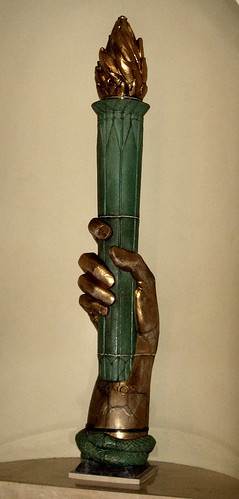
Some more Lawrie work. According to the library’s website, the Statue of Civilization "symbolizes all the Library represents.” For lists of what’s written on her book and what the symbols on the panels stand for, click here. To her left (your right) is one of a pair of Belgian marble sphinxes acting as guards.
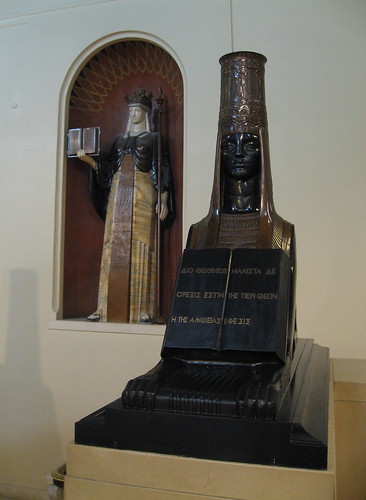
"Therefore the desire of Truth, especially of that which concerns the gods, is itself a yearning after Divinity."
When you enter the Children’s Literature Department (formerly the History Department), you’ll see a series of California history murals by Albert Herter.
Inside the International Languages Department there are friezes by Julian E. Garnsey and A.W. Parsons of Scott’s Ivanhoe. There are ten paintings. (They're brighter in person - ed.)
Therman Statom created these three chandeliers in the Bradley Wing atrium. They represent the natural, the man-made, and the spiritual worlds.
This is one of the atrium’s lanterns, called Illumination, by Anne Preston. The top part is supposed to be an upside-down human profile. Flip over your computer and let me know what you think.
One last thing. I didn’t include a shot of the interiors of the library’s elevators whosewalls are made up of old card catalog cards. The pictures are real blurry. But if you go to the library, see them (the elevators, not my blurry pictures).
There's a lot more information and pictures of the landmark's artwork at Public Art in L.A. You should read it before your next trip to the library. You can also print out a self-guided tour here. There are volunteer docents to give free tours, too, although the guide was a no-show when I was there.
The Central Library Building is also listed on the National Register of Historic Places.
Up next: St John's Episcopal Library

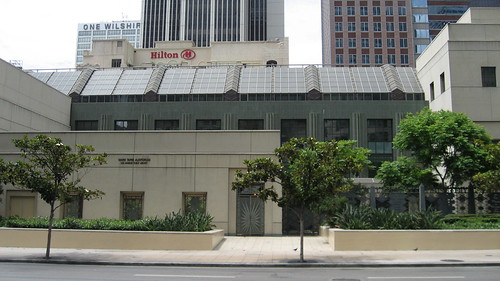
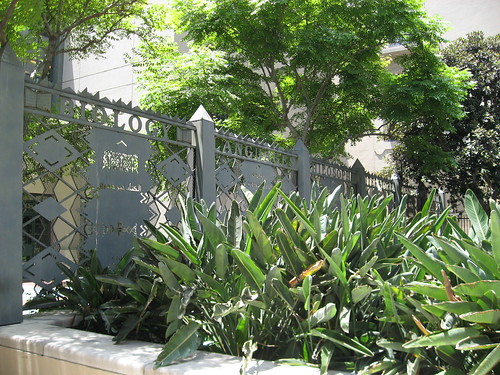

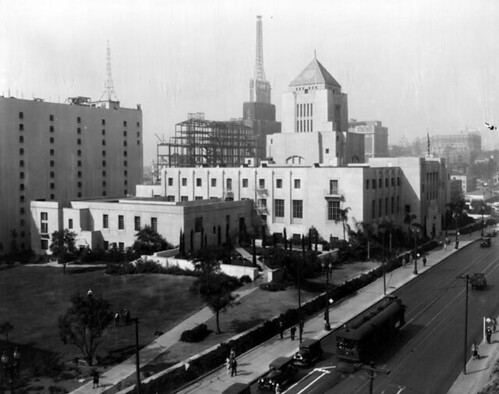
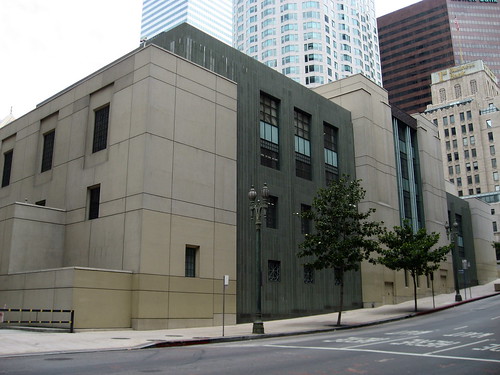
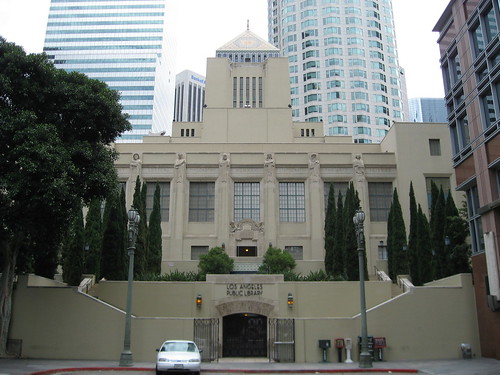
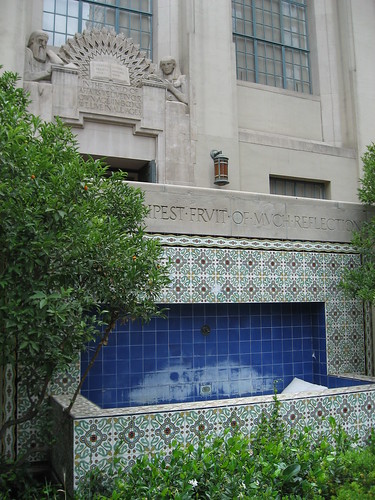
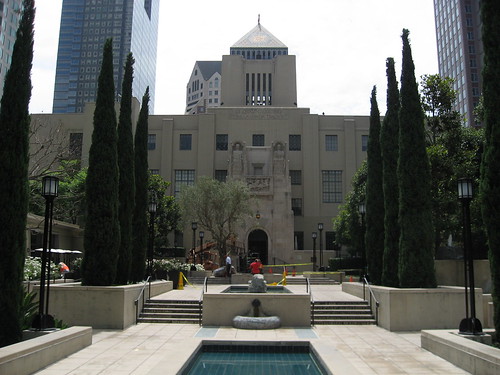
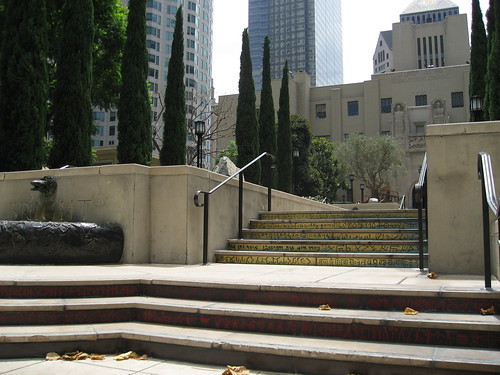

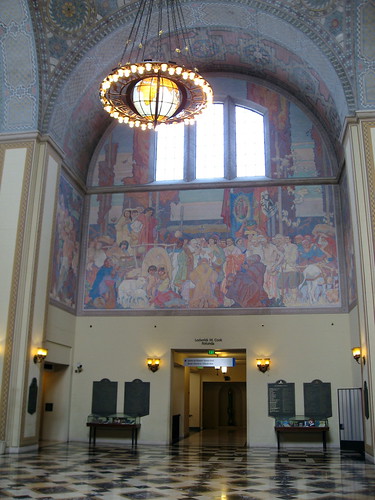

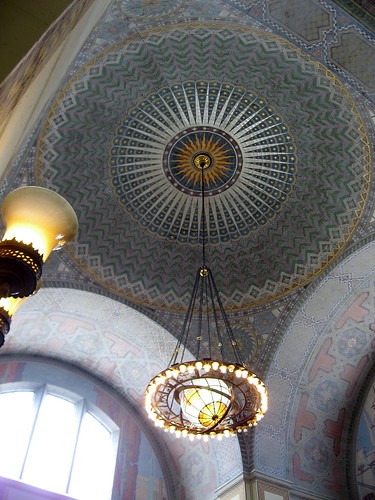
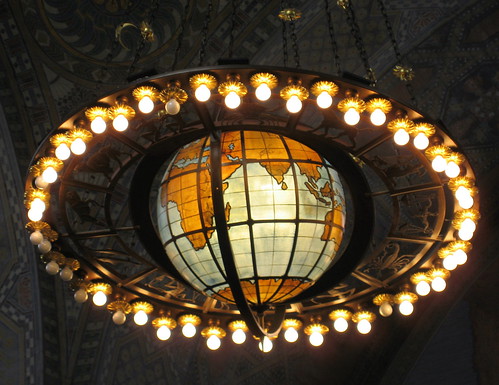
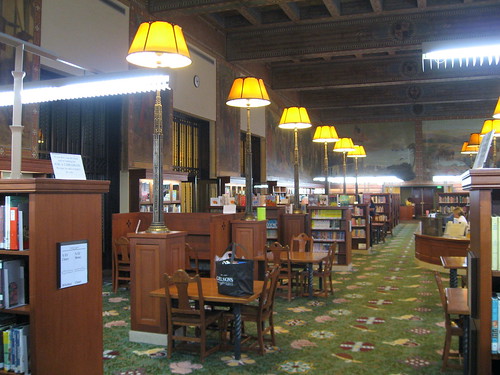
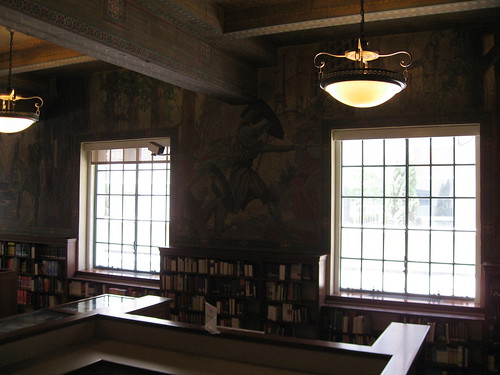

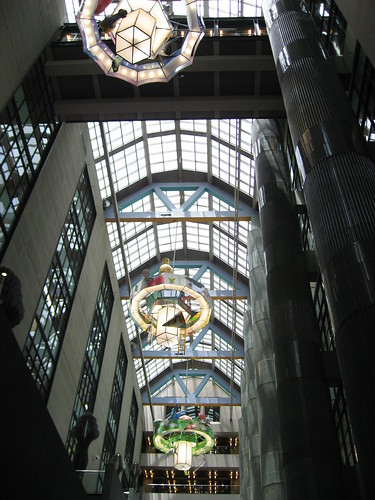

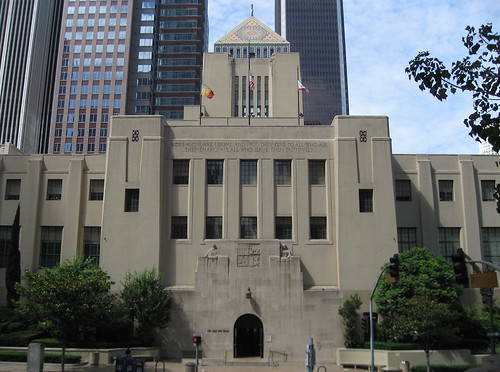
"Wisdom is the ripest fruit of much reflection", except with v's for u's.
ReplyDeleteYou are a funny one, Floyd.
And thanks for pointing out that the Illumination sculpture is an upside down profile. I never noticed that before.
Great page, Floyd! I've just recently discovered the Central Library and am soaking up as much as I can about it. Your piece makes fine primer. Thank you!
ReplyDeleteThanks, anonymous. You're right, it's the tip of the iceberg. I wish I had more time to take advantage of what the Central Library has to offer.
ReplyDeleteHello Floyd -- The Library is one of my most favorite buildings. I love the design and Egyptian motif. I was working at the ARCO Plaza the day of the fire. It was a mid-day nightmare. The photo in your blog shows the fire in the morning. It was taken from the 444 building on 5th Street. The Plaza is to the right on Flower Street. At one point the firemen nearly had it out. The black smoke was turning white. Then, somehow, it got out of hand and raced across the building to the right of your photo toward Flower Street. The fire raged with such ferocity that the flames were shooting out the windows. It took several more hours, well into the afternoon, to put it out. Although tragic, the restoration was phenomenal. Also, early photos show a landscape where in your photo there was then a parking lot. Happily, the landscape was also restored with a lovely park, some beautiful trees and fountains. There is also a small coffee and sandwich shop on the north, 5th Street, side. -- Robert
ReplyDelete